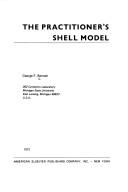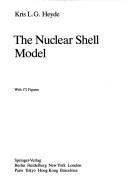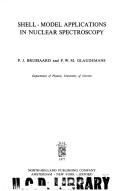| Listing 1 - 10 of 10 |
Sort by
|
Book
ISBN: 0849346347 Year: 1989 Publisher: Boca Raton CRC
Abstract | Keywords | Export | Availability | Bookmark
 Loading...
Loading...Choose an application
- Reference Manager
- EndNote
- RefWorks (Direct export to RefWorks)
Nuclear fission --- Nuclear shell theory --- Radioactive decay --- Radioactivity
Book
ISBN: 0198515162 9780198515166 Year: 1980 Publisher: Oxford : Clarendon Press,
Abstract | Keywords | Export | Availability | Bookmark
 Loading...
Loading...Choose an application
- Reference Manager
- EndNote
- RefWorks (Direct export to RefWorks)
Nuclear physics --- Nuclear shell theory --- Nuclear physics. --- Nuclear shell theory. --- Nuclear shell models --- Nuclear shell structure --- Shell models (Nuclear physics) --- Nuclear models --- Atomic nuclei --- Atoms, Nuclei of --- Nucleus of the atom --- Physics

ISBN: 072040214X 0444103481 9780444103482 9780720402148 Year: 1972 Publisher: Amsterdam : New York : North-Holland Publishing Company American Elsevier Publishing Company,
Abstract | Keywords | Export | Availability | Bookmark
 Loading...
Loading...Choose an application
- Reference Manager
- EndNote
- RefWorks (Direct export to RefWorks)
Nuclear physics --- 539.1 --- Nuclear physics. Atomic physics. Molecular physics --- Nuclear shell theory. --- Atoms --- Nuclei --- Shell models --- Shell models. --- 539.1 Nuclear physics. Atomic physics. Molecular physics --- Nuclear shell theory

ISBN: 354051581X 038751581X 3642972055 3642972039 9780387515816 9783540515814 Year: 1990 Volume: 3 Publisher: Berlin : Springer,
Abstract | Keywords | Export | Availability | Bookmark
 Loading...
Loading...Choose an application
- Reference Manager
- EndNote
- RefWorks (Direct export to RefWorks)
Models [Nuclear ] --- Modèles en couches (Physique nucléaire) --- Modèles nucléaires --- Nucleaire modellen --- Nucleaire structuur --- Nuclear models --- Nuclear shell models --- Nuclear shell structure --- Nuclear shell theory --- Nuclear structure --- Shell models (Nuclear physics) --- Structure [Nuclear ] --- Structure nucléaire --- Nuclear shell theory. --- Nuclear models. --- Nuclear structure. --- 539.142 --- Structure, Nuclear --- Nuclear physics --- Models, Nuclear --- 539.142 Nuclear models

ISBN: 0720403367 9780720403367 Year: 1977 Publisher: Amsterdam ; : North-Holland,
Abstract | Keywords | Export | Availability | Bookmark
 Loading...
Loading...Choose an application
- Reference Manager
- EndNote
- RefWorks (Direct export to RefWorks)
Theoretical spectroscopy. Spectroscopic techniques --- fysicochemie --- Experimental nuclear and elementary particle physics --- Nuclear physics --- Nuclear spectroscopy --- Nuclear shell theory --- Nuclear spectroscopy. --- Nuclear shell theory. --- 539.17 --- Spectroscopy, Nuclear --- Nuclear reactions --- Radiation --- Spectrum analysis --- Nuclear shell models --- Nuclear shell structure --- Shell models (Nuclear physics) --- Nuclear models --- Nuclear reactions. Fission. Fusion. Chain reactions etc. --- 539.17 Nuclear reactions. Fission. Fusion. Chain reactions etc. --- Nuclear reactions. Fission. Fusion. Chain reactions etc
Book
ISBN: 0720403413 0444109625 Year: 1975 Publisher: Amsterdam London : New York, NY : North-Holland American Elsevier,
Abstract | Keywords | Export | Availability | Bookmark
 Loading...
Loading...Choose an application
- Reference Manager
- EndNote
- RefWorks (Direct export to RefWorks)
Hartree-Fock approximation --- -Nuclear shell theory --- -Self-consistent field theory --- -539.1 --- SCF theory --- Self consistent field method --- Self consistent fields --- Field theory (Physics) --- Molecular orbitals --- Nuclear shell models --- Nuclear shell structure --- Shell models (Nuclear physics) --- Nuclear models --- Hartree approximation --- Hartree-Fock-Slater approximation --- Approximation theory --- Atoms --- Energy-band theory of solids --- Many-body problem --- Self-consistent field theory --- Congresses --- Nuclear physics. Atomic physics. Molecular physics --- Nuclear physics. --- Nuclei --- Field theory (Physics). --- Self-consistent field theory. --- 539.1 Nuclear physics. Atomic physics. Molecular physics --- Nuclear shell theory --- 539.1
Book
ISBN: 3540580727 0387580727 3642790542 3642790526 9783540580720 Year: 1994 Publisher: Berlin New York Tokyo Springer-Verlag
Abstract | Keywords | Export | Availability | Bookmark
 Loading...
Loading...Choose an application
- Reference Manager
- EndNote
- RefWorks (Direct export to RefWorks)
Models [Nuclear ] --- Modèles en couches (Physique nucléaire) --- Modèles nucléaires --- Nucleaire modellen --- Nucleaire structuur --- Nuclear models --- Nuclear shell models --- Nuclear shell structure --- Nuclear shell theory --- Nuclear structure --- Shell models (Nuclear physics) --- Structure [Nuclear ] --- Structure nucléaire --- 539.142 --- Structure, Nuclear --- Nuclear physics --- Models, Nuclear --- 539.142 Nuclear models
Book
ISBN: 8200071499 Year: 1984 Publisher: Bergen Universitetsforlaget
Abstract | Keywords | Export | Availability | Bookmark
 Loading...
Loading...Choose an application
- Reference Manager
- EndNote
- RefWorks (Direct export to RefWorks)
539.1 --- Nuclear physics --- -Nilsson model --- Deformed shell model --- Model, Nilsson --- Shell model, Deformed --- Nuclear models --- Nuclear shell theory --- Nuclear spectroscopy --- Nuclear structure --- Atomic nuclei --- Atoms, Nuclei of --- Nucleus of the atom --- Physics --- Nuclear physics. Atomic physics. Molecular physics --- Mathematical models --- Nilsson model. --- Mathematical models. --- 539.1 Nuclear physics. Atomic physics. Molecular physics --- Nilsson model
Book
ISBN: 443154741X 4431542337 4431542345 129933766X Year: 2013 Publisher: Tokyo : Springer Japan,
Abstract | Keywords | Export | Availability | Bookmark
 Loading...
Loading...Choose an application
- Reference Manager
- EndNote
- RefWorks (Direct export to RefWorks)
This thesis describes a novel and robust way of deriving a Hamiltonian of the interacting boson model based on microscopic nuclear energy density functional theory. Based on the fact that the multi-nucleon induced surface deformation of finite nucleus can be simulated by effective boson degrees of freedom, intrinsic properties of the nucleon system, obtained from self-consistent mean-field method with a microscopic energy density functional, are mapped onto the boson analog. Thereby, the excitation spectra and the transition rates for the relevant collective states having good symmetry quantum numbers are calculated by the subsequent diagonalization of the mapped boson Hamiltonian. Because the density functional approach gives an accurate global description of nuclear bulk properties, the interacting boson model is derived for various situations of nuclear shape phenomena, including those of the exotic nuclei investigated at rare-isotope beam facilities around the world. This work provides, for the first time, crucial pieces of information about how the interacting boson model is justified and derived from nucleon degrees of freedom in a comprehensive manner.
Nuclear physics. --- Nuclear shell theory. --- Nuclear structure. --- Interacting boson models --- Density functionals --- Physics --- Physical Sciences & Mathematics --- Electricity & Magnetism --- Bosons. --- Physics. --- Magnetism. --- Natural philosophy --- Philosophy, Natural --- Bose-Einstein particles --- Mathematical physics. --- Superconductivity. --- Superconductors. --- Magnetic materials. --- Strongly Correlated Systems, Superconductivity. --- Magnetism, Magnetic Materials. --- Theoretical, Mathematical and Computational Physics. --- Mathematical Applications in the Physical Sciences. --- Mathematical physics --- Electricity --- Magnetics --- Physical sciences --- Dynamics --- Particles (Nuclear physics) --- Interacting boson-fermion models --- Superconducting materials --- Superconductive devices --- Cryoelectronics --- Electronics --- Solid state electronics --- Electric conductivity --- Critical currents --- Superfluidity --- Physical mathematics --- Materials --- Mathematics
Book
ISBN: 3319013920 3319013939 Year: 2013 Publisher: Cham : Springer International Publishing : Imprint: Springer,
Abstract | Keywords | Export | Availability | Bookmark
 Loading...
Loading...Choose an application
- Reference Manager
- EndNote
- RefWorks (Direct export to RefWorks)
Extensions to the No-Core Shell Model presents three extensions to the No-Core Shell Model (NCSM) that allow for calculations of heavier nuclei, specifically for the p-shell nuclei. The Importance-Truncated NCSM (IT-NCSM) formulated on arguments of multi-configurational perturbation theory selects a small set of basis states from the initially large basis space in which the Hamiltonian is diagonalized. Previous IT-NCSM calculations have proven reliable, however, there has been no thorough investigation of the inherent error in the truncated IT-NCSM calculations. This thesis provides a detailed study of IT-NCSM calculations and compares them to full NCSM calculations to judge the accuracy of IT-NCSM in heavier nuclei. When IT-NCSM calculations are performed, one often needs to extrapolate the ground-state energy from the finite basis (or model) spaces to the full NCSM model space. In this thesis a careful investigation of the extrapolation procedures was performed. On a related note, extrapolations in the NCSM are commonplace, but up to recently did not have the ultraviolet (UV) or infrared (IR) physics under control. This work additionally presents a method that maps the NCSM parameters into an effective-field theory inspired framework, in which the UV and IR physics are treated appropriately. The NCSM is well-suited to describe bound-state properties of nuclei, but is not well-adapted to describe loosely bound systems, such as the exotic nuclei near the neutron drip line. With the inclusion of the Resonating Group Method (RGM), the NCSM / RGM can provide a first-principles description of exotic nuclei and the first extension of the NCSM.
Laser pulses, Ultrashort. --- Physics --- Physical Sciences & Mathematics --- Nuclear Physics --- Atomic Physics --- Nuclear shell theory. --- Nuclear models. --- Models, Nuclear --- Nuclear shell models --- Nuclear shell structure --- Shell models (Nuclear physics) --- Physics. --- Quantum field theory. --- String theory. --- Nuclear physics. --- Heavy ions. --- Hadrons. --- Elementary particles (Physics). --- Elementary Particles, Quantum Field Theory. --- Nuclear Physics, Heavy Ions, Hadrons. --- Quantum Field Theories, String Theory. --- Nuclear physics --- Nuclear models --- Quantum theory. --- Atomic nuclei --- Atoms, Nuclei of --- Nucleus of the atom --- Quantum dynamics --- Quantum mechanics --- Quantum physics --- Mechanics --- Thermodynamics --- Models, String --- String theory --- Nuclear reactions --- Ions --- Relativistic quantum field theory --- Field theory (Physics) --- Quantum theory --- Relativity (Physics) --- Elementary particles (Physics) --- High energy physics --- Nuclear particles --- Nucleons
| Listing 1 - 10 of 10 |
Sort by
|

 Search
Search Feedback
Feedback About UniCat
About UniCat  Help
Help News
News